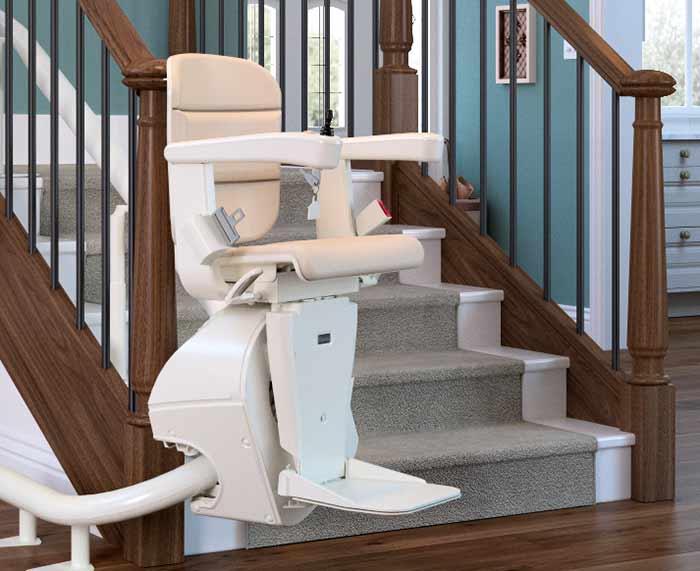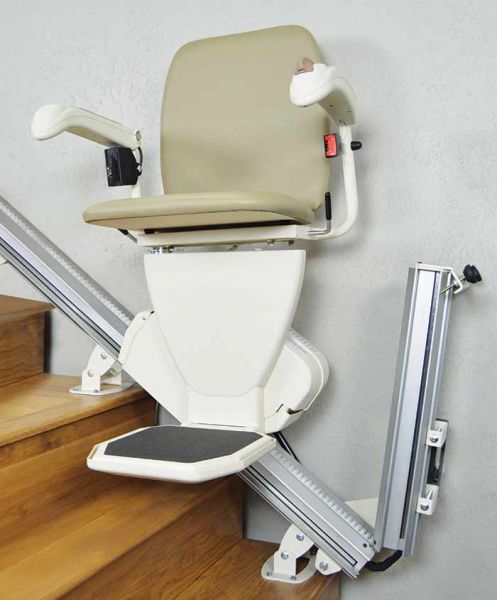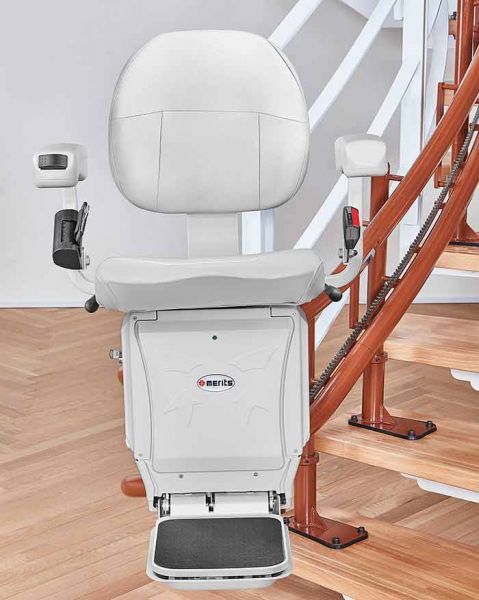HANDICARE
 Freecurve Curved Stairlift
Freecurve Curved StairliftJeremy Bespalko , Vice President of Sales handicareusa.com What are the current trends in the stairlift market? BESPALKO: More seniors are seeing the value of aging in place, often looking for products that allow them to remain independent in their own homes. Stairlifts are a perfect solution and include an abundance of optional features to meet the user’s mobility needs. More importantly a stairlift’s ability to be installed on nearly any staircase makes adapting one to a home easy. Handicare curved stairlifts are all custom-designed and made-to-order for each home, ensuring a tight fit without sacrificing safety. What are the current challenges in the stairlift market? BESPALKO: Fixed incomes, including a lack of funding through Medicare and insurance policies, continue to challenge the industry. To ensure no one has to choose between safety and household expenses, Handicare offers an array of products at a range of prices. How do stairlifts enable successful aging in place? BESPALKO: According to AARP, more than 90 percent of seniors would prefer living at home for as long as possible versus 10 percent who see moving as a viable option. Emotional ties, familiarity with their community and overall affordability all play a part in a senior’s choice to live at home. Thankfully, stairlifts are one of the easiest preventive tools to install that allow seniors to age in place. Stairlifts eliminate the fall risk on one of the most challenging environmental aspects of a home—the stairs. What certifications and training does a provider need to install stairlifts? BESPALKO: In some states and local municipalities, residential and/or commercial stairlift installations require special permits. In a select few (i.e., Connecticut, Minnesota and Rhode Island), the installer is required to be licensed by the state. Beyond that, any dealer with installation proficiency can get into the stairlift business. Handicare offers stairlift training certified by the National Association of Elevator Contractors that is both certified elevator technician (CET) and certified accessibility technician (CAT) compliant. How does providing stairlifts help HME dealers realize profitability? BESPALKO: Beyond adding a new source of revenue, dealers can find immediate success by tapping into their existing customer base. Customers who have previously purchased walkers, canes or lift chairs may not even know what a stairlift is, much less how one can keep them safe and at home longer. Stairlifts offer dealers the opportunity to expand a solutions-based approach to addressing their client’s in-home safety needs.
HARMAR
 Pinnacle Premium Stairlift
Pinnacle Premium StairliftDavid Baxter, Vice President, Product Strategy harmar.com What are the current trends in the stairlift market? BAXTER: 1) Greater product awareness leading to people investing at an earlier age. We see this as a bit of a paradigm shift. Stairlifts are being positioned to help prevent wear and tear on knees and hips—not just a way to deal with injuries after the fact. 2) It’s all about space. We are seeing increased adoption of folding rail configurations to maintain desired space at the landing and more demand for our narrowest units to minimize stairway intrusion. These space-saving features make it easier for people not using the lift to utilize the stairs and walkways at the landing. 3) Style. Users are increasingly looking for products that blend into their décor. What are the current challenges in the stairlift market? BAXTER: Well-publicized increases in material costs, domestic and foreign, driven by tariffs and market speculation, are raising costs, even for U.S.-produced components, which is in turn raising the cost of stairlifts throughout the supply chain. How do stairlifts enable successful aging in place? BAXTER: Many people try and avoid their stairs and actually stop using their second floor to deal with the struggle. A stairlift provides confidence: confidence that a person can move throughout their home without the fear of falling or pain of climbing and especially descending the staircase. When someone lives alone, their family will have less worry about mom or dad struggling on their stairs. People have a strong desire to stay in the home they love and not go through the cost and hassle of moving. What certifications and training does a provider need to install stairlifts? BAXTER: This varies by state. Some states have licensing requirements and even go as far to require elevator contractors do the work. At Harmar, our position is that any stairlift being installed should be done by a manufacturer-trained and certified dealer or installer. All Harmar dealers have access to our technical training held at our company locations. This training is complemented through an online learning portal to help installers and dealer technical personnel keep up with changes. How does providing stairlifts help HME dealers realize profitability? BAXTER: Stairlifts are a popular item with an estimated 100,000-plus units sold every year in North America. For HME dealers, this is a cash-sale product not subject to price controls or competitive bidding. In the HME’s product mix, a stairlift can bring in great profit in the thousands of dollars depending on the model. Plus, stairlifts are a great product for service/maintenance contracts, which can help deepen the relationship with the customer and their evolving needs.
MERITS HEALTH PRODUCTS
 Navigator Stairlift
Navigator StairliftAndy Scothern, National Sales Manager-Pilot meritsusa.com What are the current trends in the stairlift market? SCOTHERN: Demand for stairlifts continues to grow as baby boomers age. This along with the demand for higher-quality of life and aging independently contribute to the rising demand for stairlifts. Other trends we see are demand for an esthetically pleasing design and demand for well-designed units that fit within a decor of a home. What are the current challenges in the stairlift market? SCOTHERN: There is an increase of lifts sold with self-installation, which brings negative reviews and negative or no post-sales support. These reviews can be found if customers are researching a unit. We feel all installations should be done by a professional installer to ensure proper installation and post-sales support. How do stairlifts enable successful aging in place? SCOTHERN: Many homes are multi-level and a stairlift allows people to live in their full home and not be relegated to only one level or try to dangerously navigate the stairs on their own. What training does your company provide? SCOTHERN: We offer multiple training and certification opportunities throughout the year for dealers to become certified. We carry out some onsite intensive one-day training courses where dealers can become certified to install our lifts. How does providing stairlifts help HME dealers realize profitability? SCOTHERN: Stairlifts are typically a 100-percent cash purchase. For HME providers used to waiting on authorized insurance payments for 90 days, getting paid at the time of install is great. For Pilot, most surveys can be done in about 20 minutes and installation of our straight stairlift can be done by one installer and takes one to two hours. Labor efficiency is also important when looking at profitability.
